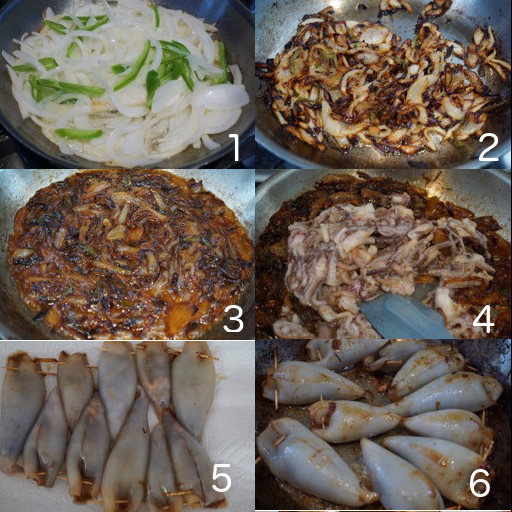I served this immediately off the frying pan and made a quick sauce by deglazing the pan with white wine. I garnished it with our favorite Spanish olive oil and parsley and served with wedges of lemon. My wife added small slices of baguette to soak up the sauce/juice.
This was quite good but when we cut into it while it was still hot the stuffing tended to separate and fall out. The next day, I served this cold. This time I sliced the squid before serving and the stuffing stayed put. We like this dish cold. The sweetness of the caramelized onion gets milder or smoother. I served it with a bit of the olive oil and our home grown arugula.
Ingredients:
1 lb cleaned squid with tentacles (I got 11 bodies and tentacles)
2 medium onion, cut in half and sliced
1 jalapeno pepper, de-veined and seeded, cut into thick julienne (original recipe uses green pepper)
2 tbs olive oil
1 clove garlic, minced (original recipe calls for crushed garlic without removing the skin)
1/2 cup of white wine (I used sauvignon blanc from France), devided into two potions
Salt and pepper to taste
Directions:
Sauté the onion, garlic and pepper in olive oil on low-medium flame (#1)
Keep sautéing until caramelized (#2)
Deglaze the pan using 1/4 cup white wine (#3)
Add the tentacles (I cut them up into bite sized pieces) and sauté until done (1-2 minutes (#4) and season with salt and pepper.
Using a small spoon stuff the body of the squid with caramelized onion/tentacles mixture and close the end with toothpicks (original recipe does not closed the open end before cooking) (#5)
Add a bit more olive oil to the pan and cook one side for a few minutes and turn over and cook for another few minutes (#6)
I added 1/4 white wine and put on the lid to steam cook for 1 more minute. Remove the squid.
Reduce the wine while scraping any brown bits on the pan to make pan juice/sauce.

I used "Francois de La Roche Touraine Sauvignon Blanc 'La Coulée' 2016" in the sauce and also enjoyed "sampling" it while cooking. I served it with the squid dish.
Either warm or cold, this is a good and unique squid dish. The caramelized onion is very sweet and squid legs add additional texture. Using the same wine we are drinking somehow connects the dish and wine. Although we rarely drink white wine especially sauvignon blanc (sort of boring nothing wine usually). This one is not too bad. It had citrus and melons flavors and minerality with crisp acidity. By the time, we got to drinking this wine with the squid dish, the wine warmed up enough to have the flavors come alive. We really enjoyed the wine and the dish.





























